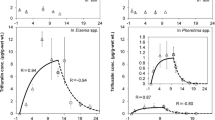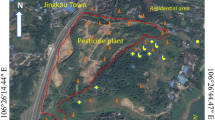Abstract
An achievable way to evaluate the bioavailability of a certain toxic in the environment is to measure the concentration inside soil organisms. Non-target saprotrophic organisms like isopods are often exposed to agrochemicals or other kind of persistent chemicals. In this study the isopod Porcellionides pruinosus was exposed to a constant concentration of Lindane (γ-HCH) via food. Using toxicokinetic models the bioaccumulation and fate of the pesticide by isopods was assessed and compared with previous studies, where an unexpected decrease in γ-HCH concentration was observed. Animal body burdens showed higher values, and a lower assimilation rate constant, although the elimination rate constant was twice the value previously observed. It was also observed that a significant amount of γ-HCH had an unknown fate. To discover its possible destiny, a factorial experiment was carried out using two types of CO2 traps and contaminated leaves in the presence and absence of isopods. It was concluded that isopod activity might have been responsible for a more rapid biotransformation of γ-HCH in leaves, since the amount of the pesticide is reduced in their presence.
Similar content being viewed by others
References
Bayley, M. (1995). Prolonged effects of the insecticide dimethoate on locomotor behaviour in the woodlouse Porcellio scaber Latr. (Isoppoda). Ecotoxicology 4, 79–90.
De Knecht, J.A., Stroomberg, G.J., Tump, C., Helms, M., Verweij, R.A., Commandeur, J., Van Gestel, C.A.M. and Van Straalen, N.M. (2001). Characterization of enzymes involved in biotransformation of polycyclic aromatic hydrocarbons in terrestrial isopods. Environ. Toxicol. Chem. 20, 1457–64.
Drobne, D. (1997). Terrestrial isopods-a good choice for toxicity testing of pollutants in the terrestrial environment. Environ. Toxicol. Chem. 16, 1159–64.
Haimi, J. (2000). Decomposer animals and bioremediation of soils. Environ. Pollut. 107, 233–8.
Jones, K.C. (1998). Introduction to the special issue on air-surface exchange of persistent organic pollutants (POPs). Environ. Pollut. 102, 1.
Lock, K., De Schamphelaere, K.A.C. and Janssen, C.R. (2002). The effects of lindane on terrestrial invertebrates. Arch. Environ. Contam. Toxicol. 42, 217–21.
Moriarty, F. and Walker, C.H. (1987). Bioaccumulation in food chains — a rational approach. Ecotoxicol. Environ. Safety 13, 208–15.
Sousa, J.P., Loureiro, S., Pieper, S., Frost, M., Kratz, W., Nogueira, A.J.A. and Soares, A.M.V.M. (2000). Soil and plant diet exposure routes and toxicokinetics of lindane in a terrestrial isopod. Environ. Toxicol. Chem. 19, 2557–63.
StatSoft (1997). Statistica for Windows. Tulsa, USA: StatSoft Inc.
Vink, K., Dewi, L., Bedaux, J. and Tompot, A. (1995). The importance of the exposure route when testing the toxicity of pesticides to saprotrophic isopods. Environ. Toxicol. Chem. 14, 1225–32.
Vink, K. and Van Straalen, N. (1999). Effects of benomyl and diazinon on isopod-mediated leaf litter decomposition in microcosms. Pedobiologia 43, 345–59.
Widianarko, B. and Van Straalen, N.M. (1996). Toxicokinetics-based survival analysis in bioassays using nonpersistent chemicals. Environ. Toxicol. Chem. 15, 402–6.
Zimmer, M., Kautz, G. and Topp, W. (1996). Olfaction in terrestrial isopods (Crustacea: Oniscidea): responses of Porcellio scaber to the odour of litter. Eur. J. Soil Biol. 32, 141–7.
Author information
Authors and Affiliations
Corresponding author
Rights and permissions
About this article
Cite this article
Loureiro, S., Sousa, J., Nogueira, A. et al. Assimilation Efficiency and Toxicokinetics of 14C-lindane in the Terrestrial Isopod Porcellionides pruinosus: The Role of Isopods in Degradation of Persistent Soil Pollutants. Ecotoxicology 11, 481–490 (2002). https://doi.org/10.1023/A:1021013519330
Issue Date:
DOI: https://doi.org/10.1023/A:1021013519330




